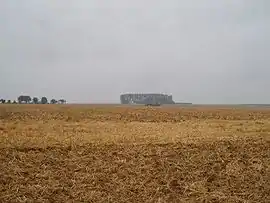Contalmaison
Contalmaison (French pronunciation: [kɔ̃talmɛzɔ̃]) is a commune in the Somme department in Hauts-de-France in northern France.
Contalmaison | |
|---|---|
 Fields in Contalmaison | |
.svg.png.webp) Coat of arms | |
Location of Contalmaison | |
 Contalmaison  Contalmaison | |
| Coordinates: 50°01′26″N 2°43′52″E | |
| Country | France |
| Region | Hauts-de-France |
| Department | Somme |
| Arrondissement | Péronne |
| Canton | Albert |
| Intercommunality | Pays du Coquelicot |
| Government | |
| • Mayor (2020–2026) | Jocelyne Gougeon[1] |
| Area 1 | 5.67 km2 (2.19 sq mi) |
| Population | 118 |
| • Density | 21/km2 (54/sq mi) |
| Time zone | UTC+01:00 (CET) |
| • Summer (DST) | UTC+02:00 (CEST) |
| INSEE/Postal code | 80206 /80300 |
| Elevation | 87–161 m (285–528 ft) (avg. 120 m or 390 ft) |
| 1 French Land Register data, which excludes lakes, ponds, glaciers > 1 km2 (0.386 sq mi or 247 acres) and river estuaries. | |
Geography
Contalmaison is situated on the D147 and D20 crossroads, some 30 miles (48 km) northeast of Amiens.
History
As with many towns in this part of France, Contalmaison saw a great deal of fighting during World War I and was one of the allied objectives in the first Battle of the Somme.
A high number of casualties fell on the first day: 1 July 1916. The advance from the British line in front of Albert, was led by the 34th Division, a New Army formation recruited in Edinburgh, Northumberland, Grimsby and Cambridge. Elements of the 16th Royal Scots ('McCrae's Battalion') and of Tyneside Irish battalions of the Northumberland Fusiliers succeeded in penetrating the village defences on 1 July before being outnumbered and forced to withdraw by stubborn German opposition.

The village is notable for its McCrae's Battalion Great War Memorial which honours the fallen of the 16th Royal Scots. Designed by the historian Jack Alexander, the 'Contalmaison Cairn' was unveiled in November 2004, completing a project first proposed by veterans of the battalion in 1919. As such, it remains the last of the 'original' Great War memorials to be built.[3]
Population
| Year | Pop. | ±% p.a. |
|---|---|---|
| 1968 | 84 | — |
| 1975 | 106 | +3.38% |
| 1982 | 101 | −0.69% |
| 1990 | 104 | +0.37% |
| 1999 | 98 | −0.66% |
| 2007 | 119 | +2.46% |
| 2012 | 122 | +0.50% |
| 2017 | 118 | −0.66% |
| Source: INSEE[4] | ||
See also
References
- "Répertoire national des élus: les maires". data.gouv.fr, Plateforme ouverte des données publiques françaises (in French). 2 December 2020.
- "Populations légales 2020". The National Institute of Statistics and Economic Studies. 29 December 2022.
- "McCrae's Battalion - the Contalmaison Cairn - Historical Background". 7 January 2013.
- Population en historique depuis 1968, INSEE